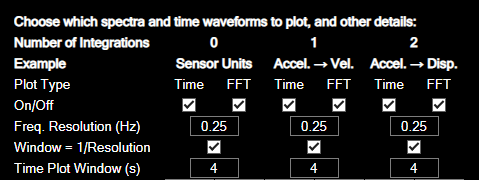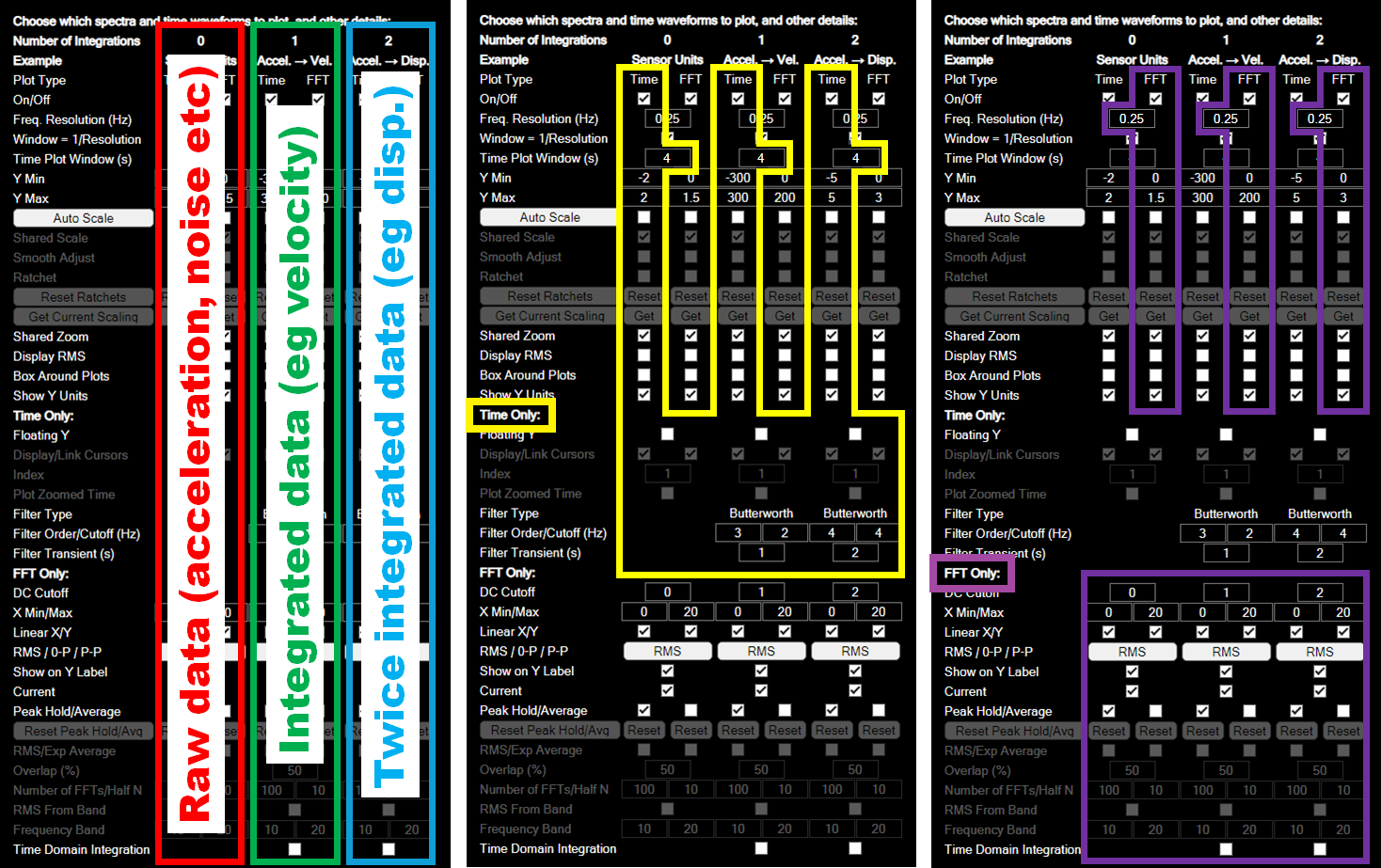Options Tab Right Panel
The right hand side panel of the Options tab allows you to turn the 6 main plot types on and off, and to change the settings for each group.
Spectra and Time Waveform Plots
The figure below shows the first few rows of the right hand panel of the options tab. The first row of check boxes allows you to turn on or off the 6 main plot types, which are:
- Time waveform of raw data (eg acceleration or noise)
- FFT of raw data
- Time waveform of integrated data (eg velocity data from acceleration)
- FFT of integrated data
- Time waveform of twice integrated data (eg displacement data from acceleration)
- FFT of twice integrated data

Frequency Resolution and Window Length
The next three rows show the frequency (bin) resolution for ffts, the time waveform duration used in analysis mode, and a button to link these. If they are linked, the frequency resolution will be the inverse of the time waveform duration, and the data shown in the time waveform plot will be the data that is used to calculate the FFT (see FFT Setup for a detailed explanation). In analysis mode, all of the time waveform data is shown, however you can still show the time window for the current FFT by disabling the peak hold and average spectra and turning on Plot Zoomed Time.
Option Grouping
The six columns below this contain (in a rough sense) the options for each of these six plot types. By default, if you turn one of these plot types on, it will be enabled for all acceleration channels (with units of g), or all channels in the case of raw data. You can turn off individual channels on the setup tab. Any options that are not currently available (for example because you are in analysis or acquisition mode) will be greyed out and inactive.
The figure below shows 3 copies of the entire right panel, showing how the options are grouped:
- Red: Raw data.
- Green: integrated data
- Blue: twice integrated data
- Yellow: time waveform plot options
- Purple: FFT plot options.

Detailed information on each option is provided below.
Common Options
On/Off: Turns the six plot types on or off for all channels.
Freq. Resolution (Hz): Bin resolution. The frequency offset between neighbouring data points on the FFT.
Window = 1/Resolution: Link the frequency resolution to the time waveform plot duration in acquisition mode, or to the zoomed time plot duration in analysis mode (if peak hold and average is turned off).
Time Plot Window (s): Time waveform plot duration in acquisition mode.
Y Min/Y Max: Y scale for each plot type. This can be over-ridden (increased) by auto scale.
Auto Scale: Automatically increase Y axis scaling.
Shared Scale: All plots of same type have same Y axis scale.
Smooth Adjust: Auto scale in very small steps
Ratchet: Do not reduce scale automatically, only increase it.
Reset Ratchets: Return to nominal Y scale specified above.
Get Current Scaling: Update the specified scale with the current scale.
Shared Zoom: To be included in next release. This is for zooming with the mouse.
Display RMS: Display text in the top left corner of each plot showing the overall RMS level.
Box Around Plots: Draw a box around the plots.
Show Y Units: Shows Ch 1 (mm/s RMS) instead of just Ch 1. Only the spectra include RMS (or 0-P/P-P). We advise against turning this off, as the amplitude is then ambiguous, however it may be convenient in situations where you have a lot of plots on one tab and the Y axis labels get too crowded and start to overlap.
Time Waveform Options
Floating Y: Y axis is not centred on zero.
Display/Link Cursors: Analysis mode only. Shows a cursor on the time waveform plot corresponding to the centre of the window used for the FFT.
Index: Time waveform data point (sample number) associated with cursor. Keep a record of this if you may want to reproduce your FFT.
Plot Zoomed Time: Analysis mode only. Shows a zoomed time waveform plot corresponding to the input data for the FFT. If peak hold or average is enabled, this plot spans all time windows used.
Filter Type: High pass filter type for time domain integration. Currently only Butterworth is available.
Filter Order/Cutoff (Hz): The number on the left in each pair is the filter order, and the number on the right is the cutoff in Hz. For the high pass filter for time domain integration.
Filter Transient (s): Discard data at the start of the integrated signal associated with filter ringing.
FFT Options
DC Cutoff:
X Min/Max:
Linear X/Y:
RMS / 0-P / P-P:
Show on Y Label:
Current:
Peak Hold/Average:
Reset Peak Hold/Avg:
RMS/Exp Average:
Overlap (%):
Number of FFTs/Half N:
RMS From Band:
Frequency Band:
Time Domain Integration: